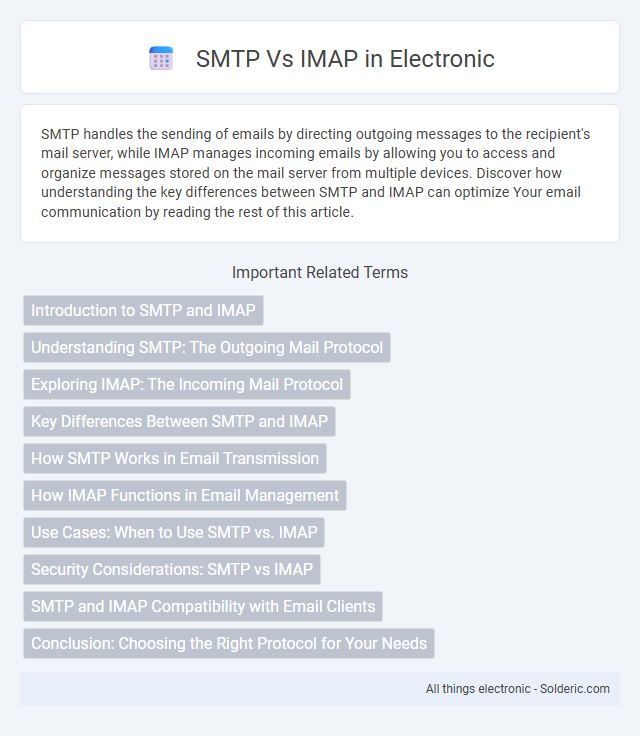SMTP handles the sending of emails by directing outgoing messages to the recipient's mail server, while IMAP manages incoming emails by allowing you to access and organize messages stored on the mail server from multiple devices. Discover how understanding the key differences between SMTP and IMAP can optimize Your email communication by reading the rest of this article.
Comparison Table
| Feature | SMTP (Simple Mail Transfer Protocol) | IMAP (Internet Message Access Protocol) |
|---|---|---|
| Primary Function | Sending emails | Receiving and managing emails |
| Email Storage | No storage; forwards emails to server | Stores emails on server, syncs across devices |
| Protocol Type | Push protocol | Pull protocol |
| Port Numbers | 25, 465 (SSL), 587 (TLS) | 143 (default), 993 (SSL) |
| Email Access | Only for sending; no inbox access | Access and manipulate inbox, folders, and messages |
| Synchronization | No synchronization | Real-time sync across multiple devices |
| Use Case | Outgoing mail servers | Incoming mail servers |
Introduction to SMTP and IMAP
SMTP (Simple Mail Transfer Protocol) is the standard protocol for sending emails across networks, ensuring your outbound messages reach the recipient's mail server securely and efficiently. IMAP (Internet Message Access Protocol) allows you to access, organize, and manage your emails directly on the mail server, providing synchronized email experience across multiple devices. Understanding the roles of SMTP and IMAP helps optimize your email communication by distinguishing sending processes from retrieval and storage.
Understanding SMTP: The Outgoing Mail Protocol
SMTP (Simple Mail Transfer Protocol) is the industry-standard protocol responsible for sending outgoing emails from your device to the recipient's mail server. Unlike IMAP, which manages incoming mail storage and synchronization, SMTP handles the transmission of outgoing messages, ensuring they reach the destination server reliably. Understanding SMTP helps you configure email clients correctly for successful email delivery and troubleshooting.
Exploring IMAP: The Incoming Mail Protocol
IMAP (Internet Message Access Protocol) enables users to access and manage emails directly on the mail server, allowing synchronization across multiple devices. Unlike SMTP, which is solely responsible for sending emails, IMAP handles incoming mail retrieval, supporting real-time email updates and folder management. Its advanced server-side functionality enhances email organization and access, making it ideal for users requiring consistent mailbox synchronization.
Key Differences Between SMTP and IMAP
SMTP (Simple Mail Transfer Protocol) is primarily used for sending emails from a client to a mail server or between servers, while IMAP (Internet Message Access Protocol) is designed for retrieving and managing emails directly on the mail server. SMTP operates on port 25, 465, or 587, focusing on outbound message delivery, whereas IMAP uses port 143 or 993 to allow users to read, organize, and synchronize emails across multiple devices. Unlike SMTP, which handles email transmission, IMAP maintains email status on the server, enabling real-time access and consistent mail management.
How SMTP Works in Email Transmission
SMTP (Simple Mail Transfer Protocol) functions as the main protocol for sending emails by transferring messages between mail servers. It operates on port 25 or 587 and manages the delivery process by breaking down the email into packets and routing them through SMTP servers until reaching the recipient's mail server. SMTP does not store messages but relies on other protocols like IMAP or POP3 for retrieving and managing emails on the recipient's device.
How IMAP Functions in Email Management
IMAP functions in email management by storing your messages on the mail server, allowing you to access and organize emails in real-time from multiple devices without downloading them permanently. It synchronizes actions like reading, deleting, or moving emails across all devices, ensuring consistency in your inbox. This server-based approach contrasts with SMTP, which is solely responsible for sending outgoing emails.
Use Cases: When to Use SMTP vs. IMAP
SMTP is primarily used for sending emails from a client to a server or between mail servers, making it essential for outgoing mail delivery in email communication workflows. IMAP is designed for retrieving and managing emails stored on a mail server, enabling users to access and organize messages across multiple devices while keeping them synchronized. Use SMTP when sending messages, and rely on IMAP for accessing, reading, and managing received emails from various locations.
Security Considerations: SMTP vs IMAP
SMTP primarily handles sending emails and often requires authentication and TLS encryption to secure message delivery, preventing interception and spoofing. IMAP manages email retrieval and storage, employing SSL/TLS protocols to protect your login credentials and data during synchronization between the email client and server. Understanding these security differences ensures your email communication remains confidential and resistant to unauthorized access.
SMTP and IMAP Compatibility with Email Clients
SMTP and IMAP protocols are widely supported by most email clients, ensuring compatibility across platforms such as Microsoft Outlook, Apple Mail, and Mozilla Thunderbird. SMTP handles the sending of emails, while IMAP manages email retrieval and synchronization, allowing your messages to stay consistent on multiple devices. This seamless integration guarantees efficient email communication and access regardless of your preferred email client.
Conclusion: Choosing the Right Protocol for Your Needs
Selecting between SMTP and IMAP depends on your email usage requirements; SMTP is essential for sending emails, while IMAP excels at managing and retrieving messages from the mail server. For users who need seamless synchronization across multiple devices and efficient message organization, IMAP offers superior functionality. Conversely, SMTP remains a critical protocol focused on the reliable delivery of outgoing emails, making it indispensable for email transmission.
SMTP vs IMAP Infographic

 solderic.com
solderic.com